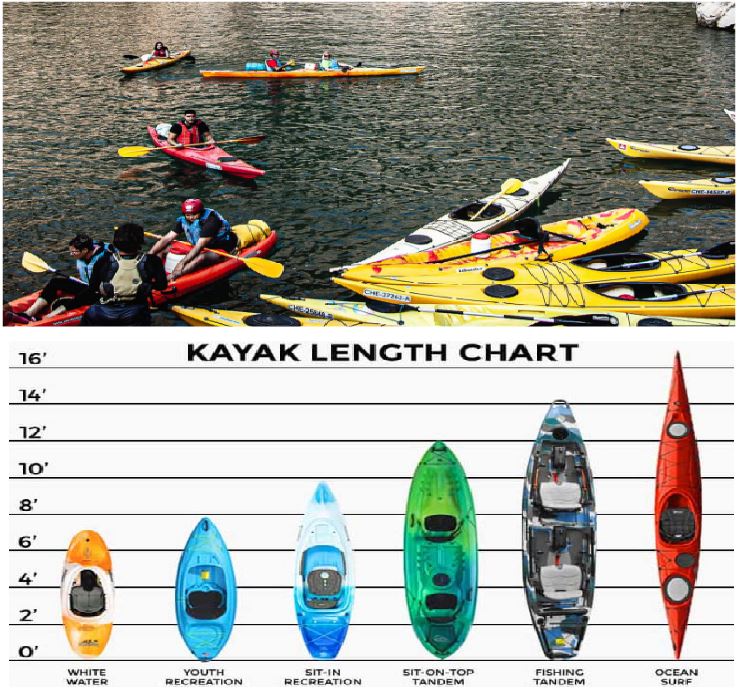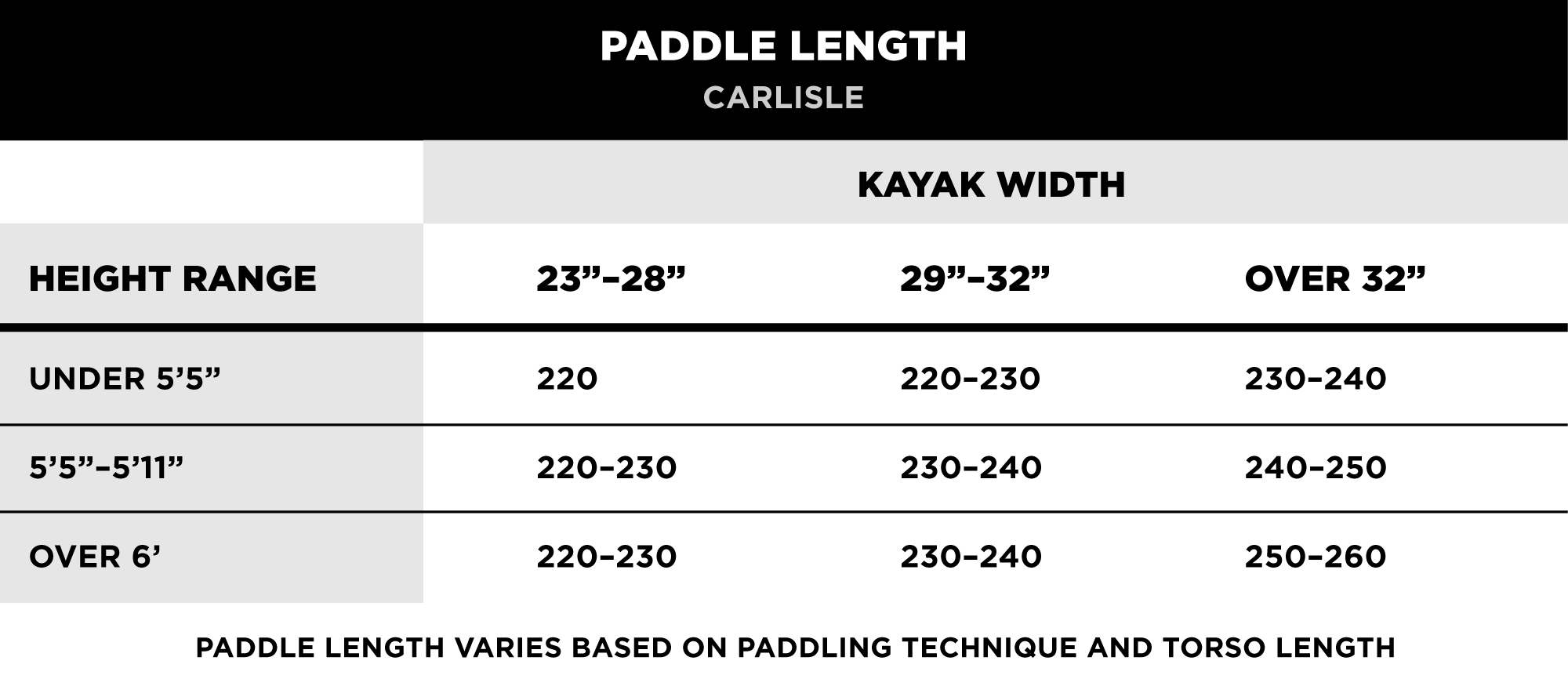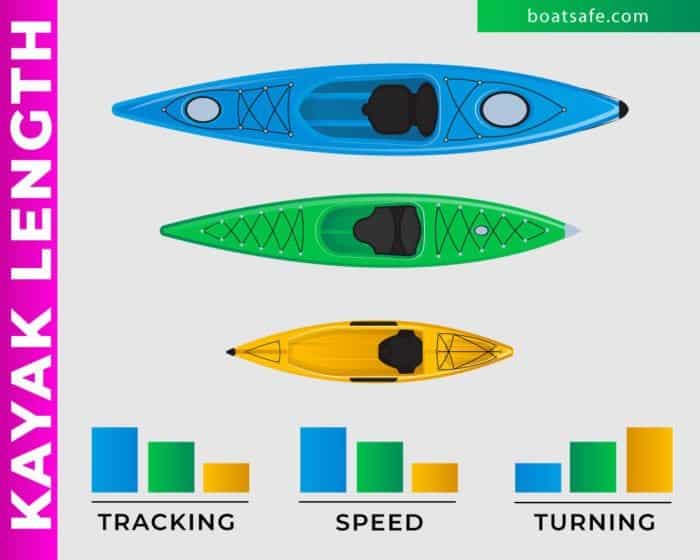To choose the correct kayak size, consider your height, weight, and intended use. Kayak length typically ranges between 6 and 16 feet for optimal performance.

For instance, taller paddlers or those carrying extra gear might prefer longer kayaks, which offer improved speed and storage. Conversely, shorter kayaks tend to be more maneuverable, making them ideal for quick turns and agile movements in whitewater or small water bodies. Remember that stability is key; a wider kayak provides more of it, which is crucial for beginners or those looking to fish. Determine your needs and align them with the correct kayak size to enhance your paddling experience.
Choosing the right size kayak is essential for comfort, safety, and performance on the water. Here are some things to consider when deciding what size kayak you need.
Body Size and Weight: Your height, weight, and body type will affect the size of the kayak you need. Taller and heavier people generally need larger kayaks with more legroom and weight capacity.
Type of Kayaking: Consider the type of kayaking you plan to do. For example, recreational kayaks are typically small and wide, providing stability and maneuverability for calm waters such as lakes and slow-moving rivers. Longer, narrower kayaks are better suited for touring and sea kayaking, offering better tracking and speed.
Skill level: Beginners may feel more comfortable in wider, more stable kayaks, while experienced paddlers may prefer narrower kayaks for speed and agility.
The Importance of Correct kayak size.
Choosing the right kayak size is crucial for enthusiasts and beginners alike. The size of your kayak can significantly influence your experience on the water. It determines key factors like stability, maneuverability, speed, and comfort, ultimately affecting your enjoyment and safety during kayaking adventures.
Influence On Performance
The size of the kayak directly affects its performance on the water. Here’s how:
- Longer kayaks generally glide faster and track straighter.
- Shorter kayaks are more agile, making turns and handling easier.
- Width plays a role in stability; wider kayaks offer more.
Matching kayak size with your specific activities ensures optimal performance.
Impact On Comfort And Safety
Kayak size also impacts your comfort and safety while paddling. Consider these points:
| Kayak Feature | Comfort | Safety |
|---|---|---|
| Cockpit Size | Should allow easy entry and exit | Must be snug enough for efficient control |
| Kayak Length | Affects legroom space | Longer kayaks might be harder to handle for some |
| Kayak Width | Wider models can be more comfortable | But can also affect the kayak’s responsiveness |
Ensuring a proper fit not only improves endurance but also enhances safety measures.

Credit: aquabound.com
Types Of Kayaks
Choosing the perfect kayak starts with understanding the types that suit various water adventures. Kayaks come in many shapes and sizes, each designed for specific conditions and user preferences. The right kayak will enhance comfort, stability, and performance. Let’s dive into the world of kayaks to find your ideal match.
Recreational Versus Touring Models
Recreational kayaks are user-friendly, stable, and suited for calm waters. They’re perfect for beginners and casual paddlers. Generally shorter, they make tight turns and maneuvering is simple.
Touring kayaks, on the other hand, are longer and sleeker. They glide smoothly through water for longer trips. Built for speed and efficiency, they perform best in open waters like lakes and coastal areas.
- Recreational Kayaks:
- Shorter length (usually under 12 feet)
- Wider hull for stability
- Best for calm waters
- Touring Kayaks:
- Longer length (over 12 feet)
- Narrower hull for speed
- Equipped for distance paddling
Sit-on-top Versus Sit-in Styles
Sit-on-top kayaks are ideal for warm climates and easy entry. Water drains through holes, So paddlers may get wet.
Sit-in kayaks enclose paddlers’ lower bodies. These offer protection from the elements, making them better for cooler conditions.
| Sit-on-top Kayaks | Sit-in Kayaks |
|---|---|
| Open deck | Enclosed cockpit |
| Self-draining scupper holes | Better for cold water protection |
| Ideal for beginners | Suitable for experienced paddlers |
Key Kayak Dimensions
Choosing a kayak involves understanding key dimensions that will affect its performance on the water. Consider the size specifications seriously to ensure you paddle away with the perfect kayak. Each measurement is crucial in how the kayak handles and suits your purpose.
Length And Its Effects
Longer kayaks often glide faster and straighter, making them ideal for covering longer distances. They provide ample storage, making them perfect for touring or camping trips. However, shorter kayaks win in maneuverability, allowing swift turns and fun on twisty rivers. Look at the following breakdown:
- Short Kayaks (under 10 feet) are Great for tight waterways
- Medium Kayaks (10 to 14 feet): A balance of stability and speed
- Long Kayaks (over 14 feet) are best for open water and speed
Width And Stability
The width of a kayak greatly influences its stability. A wider vessel is typically more stable, which is great for beginners or fishers. Narrow kayaks, contrastingly, may feel tippy but are agile and fast. Consider this when picking for recreation or exploring calm waters versus competitive racing:
| Kayak Width | Stability Type | Suggested Use |
|---|---|---|
| Under 23 inches | Less Stable | Racing, Experienced Paddlers |
| 24 – 30 inches | Moderately Stable | Recreation, Fishing |
| Over 30 inches | Very Stable | Beginners, Casual Paddling |

Credit: bendingbranches.com
Determining The Right Fit
Choosing a kayak is much like finding the perfect pair of shoes. It needs to fit well for optimal comfort and performance. This section guides you through the crucial steps to ensure your kayak is the right fit, marrying comfort with capability. Remember, the right fit isn’t just about comfort—it directly influences your control and safety on the water.
Body Size Compatibility
Your physical build is a key factor in finding the ideal kayak size. A well-fitted kayak offers stability and easy maneuvering.
- Length: Taller paddlers usually need longer kayaks.
- Width: Wider kayaks provide more room and stability.
- Cockpit Size: Ensure you can enter and exit with ease.
Personal Skill Level
Kayak size should reflect your paddling expertise. Beginners benefit from stability, while experts might prefer agility.
| Skill Level | Kayak Type | Features |
|---|---|---|
| Beginner | Recreational Kayak | Wide, stable, and easy to control |
| Intermediate | Touring Kayak | Slimmer, faster, and more maneuverable |
| Expert | Performance Kayak | Sleek design, optimized for speed |
Weight Capacity Considerations
Weight capacity considerations are crucial when selecting the right kayak. Before deciding on the size of your kayak, understanding the maximum load and buoyancy is paramount.
Maximum Load And Buoyancy
Kayaks come with a weight limit that should never be exceeded. This maximum load includes not just your body weight but also the weight of your gear. Having a proper balance enhances stability and performance. Too heavy, and your kayak might sink or capsize; too light, and it might be overly buoyant and hard to control.
Gear Storage Needs
Consider your gear storage needs, as they contribute to the overall weight. Are you planning multi-day trips or need equipment for fishing? Different kayaks offer varied storage options. Make a list of the essentials and account for their weight:
- Camping gear
- Fishing equipment
- Food and water supplies
Kayak Features And Accessories
Choosing the right size kayak is crucial for comfort and stability. Kayak features and accessories play a vital role in ensuring a perfect fit. Understanding adjustable elements and size adjustment accessories can make all the difference.
Adjustable Foot Pegs And Padding
Adjustable foot pegs are key for securing your position in a kayak. They help maintain proper leg posture. This posture supports efficient paddling. Foot pegs should match your leg length. Padding in the seat and along the cockpit edges provides additional comfort. It also helps to customize the kayak’s fit to your body. Both these features contribute to paddling effectiveness.
- Look for kayaks with multiple footrest positions.
- Check for quality padding that suits your body shape.
Additional Accessories For Size Adjustment
Various accessories can aid in achieving the perfect kayak fit. These include seat adjusters, thigh braces, and hip pads. These accessories allow for a more tailored experience.
| Accessory | Function |
|---|---|
| Seat Adjusters | Enable seat position fine-tuning |
| Thigh Braces | Offer better control and stability |
| Hip Pads | Secure the fit for various body types |
Thigh braces and hip pads secure your fit. They should be adjustable to accommodate different sizes. Look for kayaks that offer these features. Ensure they are customizable to your body’s dimensions.
Test Paddling A Kayak
Choosing the right kayak can be a splash with test paddling. Get a feel of the kayak on the water before making a decision. It ensures the size, comfort, and performance meet personal needs. Let’s dive into why in-water testing is critical and what to keep an eye on during a test paddle.
Importance Of In-water Testing
Testing a kayak in the water is crucial.
- Ensures proper fit: The cockpit size and seat comfort matter.
- Assesses stability: Feel the kayak’s balance while afloat.
- Evaluate performance: Check speed and maneuverability.
What To Look For During A Test Paddle
Here’s what to watch during a test paddle:
| Feature | What to Check |
|---|---|
| Size and Fit |
|
| Comfort |
|
| Stability |
|
| Maneuverability |
|
| Performance |
|

Credit: oldtownwatercraft.johnsonoutdoors.com
Seeking Expert Advice
Choosing the right size kayak for adventures on the water can be tricky. Experts provide essential insights tailored to your needs. They assess your skill level, size, and kayaking goals. Optimal comfort and safety hinge on such professional guidance.
Benefits Of Professional Guidance
Getting advice from a professional can make a world of difference. Here are notable benefits:
- Personalized Recommendations: Experts pinpoint the perfect kayak size for you.
- Enhanced Safety: A well-fitted kayak reduces the risk of capsizing.
- Better Performance: The right kayak improves maneuverability and efficiency.
- Long-term Comfort: Avoid discomfort and injury with professional fitment advice.
Resources For Kayak Fitting
Several resources are available for kayak fitting:
| Kayak Shops | Online Guides | Community Forums |
|---|---|---|
| Local stores offer hands-on fitting sessions. | Digital platforms host sizing charts and videos. | Fellow kayakers share insights and experiences. |
Workshops and classes by kayaking clubs are also beneficial. They provide demonstrations and practical advice. Always choose reputable sources for accurate information.
Frequently Asked Questions For How Do You Know What Size Kayak You Need?
What Factors Determine Kayak Size Selection?
When selecting a kayak, consider your weight, height, and skill level. Additionally, think about the kayak’s intended use, such as touring, fishing, or whitewater, as this dictates length and width for optimal stability and maneuverability.
How Does Paddler Size Affect Kayak Choice?
Paddler size directly influences kayak choice. A correctly sized kayak should accommodate the paddler’s weight and height for comfort and safety. A kayak with appropriate cockpit size allows for efficient control and reduces the risk of capsizing.
Can Kayak Length Impact Performance?
Yes, kayak length can greatly impact performance. Longer kayaks tend to track straighter and offer faster speeds, making them ideal for long-distance touring. Shorter kayaks are more agile, making them suitable for quick turns in rivers or surf.
What Is The Ideal Kayak Width For Stability?
The ideal kayak width for stability usually ranges between 24 to 32 inches. Wider kayaks offer increased stability, which is beneficial for beginners, anglers, or anyone using the kayak on calm water.
Conclusion
Selecting the right kayak size is vital for your comfort and safety on the water. Match your weight, height, and paddling style to the kayak’s dimensions and purpose. Always remember that the perfect fit enhances your kayaking experience. Seek expert advice if needed, and happy paddling!

